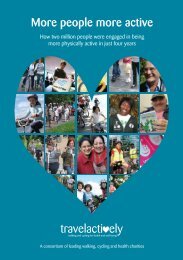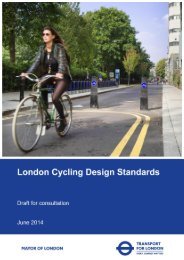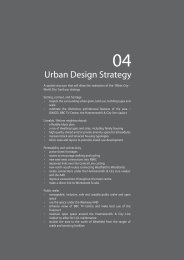Travel in London Travel in London
travel-in-london-report-8
travel-in-london-report-8
Create successful ePaper yourself
Turn your PDF publications into a flip-book with our unique Google optimized e-Paper software.
11. Spotlight: How has travel by <strong>London</strong>ers changed – <strong>in</strong>sights from 10 years of the <strong>London</strong> <strong>Travel</strong><br />
Demand Survey (LTDS)<br />
Table 11.4<br />
Reason for not mak<strong>in</strong>g a work trip on travel day, weekdays only vs. 7-day<br />
week (LTDS 2011/12 to 2013/14 average).<br />
Full-time worker<br />
Part-time worker<br />
Weekdays Whole week Weekdays Whole week<br />
Do not work on that day 50% 78% 73% 83%<br />
Not well 3% 1% 1% 1%<br />
Work<strong>in</strong>g from home 20% 9% 13% 9%<br />
On annual leave 19% 8% 7% 5%<br />
On maternity/paternity leave 5% 3% 2% 2%<br />
Other 3% 2% 2% 2%<br />
All 100% 100% 100% 100%<br />
Source: TfL Plann<strong>in</strong>g, Strategic Analysis.<br />
Summary<br />
<strong>Travel</strong> related to work accounts for 28.8 per cent of trips made by <strong>London</strong>ers on an<br />
average weekday (2014/15), and is the primary driver of the maximum capacity<br />
required by the transport networks. Increas<strong>in</strong>g flexibility of work<strong>in</strong>g patterns does<br />
appear to have fed through to an overall reduction <strong>in</strong> work-related travel demand<br />
over the 10-year review period, with an average reduction of 0.4 per cent per year <strong>in</strong><br />
commut<strong>in</strong>g trips by <strong>London</strong>ers. In absolute terms <strong>in</strong> terms of peak demand on the<br />
travel networks, however, this has been more than cancelled out by overall<br />
population growth. There is no clear trend, however, for employer’s bus<strong>in</strong>ess trips,<br />
the frequency of which has rema<strong>in</strong>ed broadly stable at the level of the <strong>in</strong>dividual.<br />
There is also evidence that <strong>London</strong>ers are travell<strong>in</strong>g more frequently between home<br />
and a work place other than the one they recognise as their ‘usual workplace’,<br />
which could be another manifestation of more flexible work<strong>in</strong>g patterns. Work<strong>in</strong>g<br />
from home, which is dist<strong>in</strong>guished by the absence of a commut<strong>in</strong>g trip but not<br />
necessarily the absence of other travel, is broadly equivalent <strong>in</strong> scale to annual<br />
leave (2012/13-2014/15) as a reason why those <strong>in</strong> full time employment do not<br />
make a commut<strong>in</strong>g trip on any given work<strong>in</strong>g day.<br />
11.7 How are changes <strong>in</strong> <strong>London</strong>’s age balance affect<strong>in</strong>g travel demand?<br />
Introduction<br />
The age profile of <strong>London</strong>’s residents affects the types of trips that <strong>London</strong>ers<br />
make, <strong>in</strong>clud<strong>in</strong>g their frequency, purpose, tim<strong>in</strong>gs and mode. This section looks at<br />
what LTDS can tell us about the travel patterns of people of different age groups,<br />
and how (if at all) these have changed over the available 10 years of data. Some of<br />
the implications of this are considered <strong>in</strong> Chapter 12 of this report, which looks at<br />
future projections of <strong>London</strong>’s population and travel demand.<br />
228 <strong>Travel</strong> <strong>in</strong> <strong>London</strong>, Report 8








